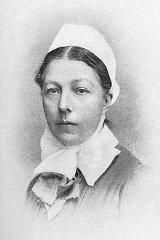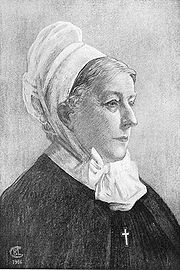
Isabella Gilmore
Encyclopedia
Isabella Gilmore was an English
churchwoman who oversaw the revival of the Deaconess
Order in the Anglican Communion
. Isabella served actively in the poorest parishes in South London for almost two decades and she is remembered with a commemoration in the Calendar of saints
in some parts of the Anglican Communion on 16 April. She was the sister of William Morris
.
in 1842. Her mother was Emma Morris née Shelton, daughter of Joseph Shelton, a teacher of music in Worcester
. Her father was William Morris, a partner in the firm of Sanderson & Co., bill brokers in the City of London
; he died when she was 5 years old. She did have five brothers to whom she was close; one of the older ones was William Morris
. In adulthood, she had a happy marriage to a naval officer, Arthur Gilmore. Her middle class
life took a turn when she was widowed at the age of 40. Childless, she began training as a nurse at Guy's Hospital
in London. Two years later in 1884, she took on as her own eight orphaned nieces and nephews from her late brother Randall.
, the Bishop of Rochester
, to revive the female diaconate
in his diocese. Her initial reluctance, based on her lack of theological training and her lack of knowledge of the Deaconess Order, was worn down by the bishop. At the end of October 1886, she felt she received a calling during Morning Prayer. She later wrote, "it was just as if God’s voice had called me, and the intense rest and joy were beyond words." Gilmore and the Bishop of Rochester proceeded to plan for an Order of Deaconesses for the Church of England
where the women were to be “a curiously effective combination of nurse, social worker and amateur policemen”. In 1887, she was ordained a deaconess and a training house for other woman was put in place, later to be named Gilmore House in her honor. Isabella served actively in the poorest parishes in South London until her retirement in 1906.
. She had personally trained at least seven other head deaconesses for other dioceses before she died in 1923. At her memorial service, Randall Davidson, the Archbishop of Canterbury
, foretold, "Some day, those who know best will be able to trace much of the origin and root of the revival of the Deaconess Order to the life, work, example and words of Isabella Gilmore. For this let us give thanks: I feel sure it is most meet and right so to do." Isabella Gilmore is remembered with a commemoration in the Calendar of saints
in some parts of the Anglican Communion
on 16 April.
English people
The English are a nation and ethnic group native to England, who speak English. The English identity is of early mediaeval origin, when they were known in Old English as the Anglecynn. England is now a country of the United Kingdom, and the majority of English people in England are British Citizens...
churchwoman who oversaw the revival of the Deaconess
Deaconess
Deaconess is a non-clerical order in some Christian denominations which sees to the care of women in the community. That word comes from a Greek word diakonos as well as deacon, which means a servant or helper and occurs frequently in the Christian New Testament of the Bible. Deaconesses trace...
Order in the Anglican Communion
Anglican Communion
The Anglican Communion is an international association of national and regional Anglican churches in full communion with the Church of England and specifically with its principal primate, the Archbishop of Canterbury...
. Isabella served actively in the poorest parishes in South London for almost two decades and she is remembered with a commemoration in the Calendar of saints
Calendar of saints (Church of England)
The Church of England commemorates many of the same saints as those in the Roman Catholic calendar of saints, mostly on the same days, but also commemorates various notable Christians who have not been canonised by Rome, with a particular though not exclusive emphasis on those of English origin...
in some parts of the Anglican Communion on 16 April. She was the sister of William Morris
William Morris
William Morris 24 March 18343 October 1896 was an English textile designer, artist, writer, and socialist associated with the Pre-Raphaelite Brotherhood and the English Arts and Crafts Movement...
.
Life
Isabella Gilmore was born in LondonLondon
London is the capital city of :England and the :United Kingdom, the largest metropolitan area in the United Kingdom, and the largest urban zone in the European Union by most measures. Located on the River Thames, London has been a major settlement for two millennia, its history going back to its...
in 1842. Her mother was Emma Morris née Shelton, daughter of Joseph Shelton, a teacher of music in Worcester
Worcester
The City of Worcester, commonly known as Worcester, , is a city and county town of Worcestershire in the West Midlands of England. Worcester is situated some southwest of Birmingham and north of Gloucester, and has an approximate population of 94,000 people. The River Severn runs through the...
. Her father was William Morris, a partner in the firm of Sanderson & Co., bill brokers in the City of London
City of London
The City of London is a small area within Greater London, England. It is the historic core of London around which the modern conurbation grew and has held city status since time immemorial. The City’s boundaries have remained almost unchanged since the Middle Ages, and it is now only a tiny part of...
; he died when she was 5 years old. She did have five brothers to whom she was close; one of the older ones was William Morris
William Morris
William Morris 24 March 18343 October 1896 was an English textile designer, artist, writer, and socialist associated with the Pre-Raphaelite Brotherhood and the English Arts and Crafts Movement...
. In adulthood, she had a happy marriage to a naval officer, Arthur Gilmore. Her middle class
Middle class
The middle class is any class of people in the middle of a societal hierarchy. In Weberian socio-economic terms, the middle class is the broad group of people in contemporary society who fall socio-economically between the working class and upper class....
life took a turn when she was widowed at the age of 40. Childless, she began training as a nurse at Guy's Hospital
Guy's Hospital
Guy's Hospital is a large NHS hospital in the borough of Southwark in south east London, England. It is administratively a part of Guy's and St Thomas' NHS Foundation Trust. It is a large teaching hospital and is home to the King's College London School of Medicine...
in London. Two years later in 1884, she took on as her own eight orphaned nieces and nephews from her late brother Randall.
Female diaconate
In 1886, she was recruited by Anthony ThoroldAnthony Wilson Thorold
Anthony Wilson Thorold was an Anglican Bishop of Winchester in the Victorian era. The son of a Church of England priest, he also served as Bishop of Rochester. It was in that role that he traveled throughout North America and met with important leaders of the Church of Jesus Christ of Latter-day...
, the Bishop of Rochester
Bishop of Rochester
The Bishop of Rochester is the ordinary of the Church of England Diocese of Rochester in the Province of Canterbury.The diocese covers the west of the county of Kent and is centred in the city of Rochester where the bishop's seat is located at the Cathedral Church of Christ and the Blessed Virgin...
, to revive the female diaconate
Deaconess
Deaconess is a non-clerical order in some Christian denominations which sees to the care of women in the community. That word comes from a Greek word diakonos as well as deacon, which means a servant or helper and occurs frequently in the Christian New Testament of the Bible. Deaconesses trace...
in his diocese. Her initial reluctance, based on her lack of theological training and her lack of knowledge of the Deaconess Order, was worn down by the bishop. At the end of October 1886, she felt she received a calling during Morning Prayer. She later wrote, "it was just as if God’s voice had called me, and the intense rest and joy were beyond words." Gilmore and the Bishop of Rochester proceeded to plan for an Order of Deaconesses for the Church of England
Church of England
The Church of England is the officially established Christian church in England and the Mother Church of the worldwide Anglican Communion. The church considers itself within the tradition of Western Christianity and dates its formal establishment principally to the mission to England by St...
where the women were to be “a curiously effective combination of nurse, social worker and amateur policemen”. In 1887, she was ordained a deaconess and a training house for other woman was put in place, later to be named Gilmore House in her honor. Isabella served actively in the poorest parishes in South London until her retirement in 1906.

Legacy
In her nearly 20 years of service, she reestablished the female diaconate in the Anglican CommunionAnglican Communion
The Anglican Communion is an international association of national and regional Anglican churches in full communion with the Church of England and specifically with its principal primate, the Archbishop of Canterbury...
. She had personally trained at least seven other head deaconesses for other dioceses before she died in 1923. At her memorial service, Randall Davidson, the Archbishop of Canterbury
Archbishop of Canterbury
The Archbishop of Canterbury is the senior bishop and principal leader of the Church of England, the symbolic head of the worldwide Anglican Communion, and the diocesan bishop of the Diocese of Canterbury. In his role as head of the Anglican Communion, the archbishop leads the third largest group...
, foretold, "Some day, those who know best will be able to trace much of the origin and root of the revival of the Deaconess Order to the life, work, example and words of Isabella Gilmore. For this let us give thanks: I feel sure it is most meet and right so to do." Isabella Gilmore is remembered with a commemoration in the Calendar of saints
Calendar of saints (Church of England)
The Church of England commemorates many of the same saints as those in the Roman Catholic calendar of saints, mostly on the same days, but also commemorates various notable Christians who have not been canonised by Rome, with a particular though not exclusive emphasis on those of English origin...
in some parts of the Anglican Communion
Anglican Communion
The Anglican Communion is an international association of national and regional Anglican churches in full communion with the Church of England and specifically with its principal primate, the Archbishop of Canterbury...
on 16 April.

